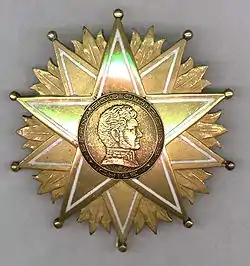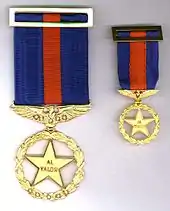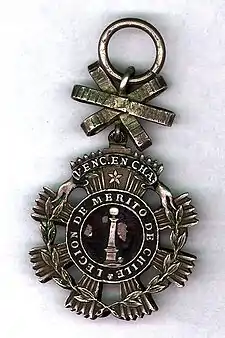Orders, decorations, and medals of Chile
The Chilean honours system provides a means for the Government of Chile to reward gallantry, achievement, or service, by both Chileans and non-citizens. The honours system consists of three types of award: orders, decorations and medals. Membership of an Order (in one of its various grades) is conferred to recognise merit in terms of achievement and service. Decorations are conferred to recognise specific deeds of gallantry, bravery, distinguished or meritorious service. Medals are conferred to recognise long and/or valuable service and/or good conduct. Awards to non-citizens are usually only made where the gallantry, achievement or service has advanced Chilean interests in some way. The honours conferred by the Chilean Republic can be divided into two groups: civil and military. Military honours are conferred by the different branches of the Armed Forces of Chile. Civil honours are conferred by the President of Chile or, in some instances, by the government minister relevant to the particular honour.
Civil Orders
Order of Merit
(Spanish: Orden del Mérito)[1]

The Order of Merit of Chile (Spanish: Orden al Mérito de Chile) was established in 1906, as a successor order to the Legion of Merit, to 'reward outstanding civil service to the Republic of Chile provided by foreign nationals'. The order is governed by the Council of the Order of Merit of Chile. The President of Chile is the Chair of the council. The remaining councilors comprise the Minister of Foreign Affairs (Chancellor of the Order), the Secretary of Foreign Affairs, the Director General Foreign Policy and the Director General Ceremonial and Protocol (Secretary of the Order) while the Deputy Director Protocol serves as the Secretary of the Order.[2] The order consists of five classes:
Order of Bernardo O'Higgins

I Class Breast Star
The Order of Bernado O'Higgins (Spanish: Orden de Bernardo O'Higgins) was established in 1956 as an extension of the Order of Merit of Chile in order to recognise foreign nationals for their 'outstanding contribution to the arts, sciences, education, industry, trade or social and humanitarian cooperation'. The Order of Bernardo O'Higgins is conferred by the Chilean President on the advice of the Minister of Foreign Relations.[2] The order was originally established in two classes:
In 1967 the order was reorganised into five classes, and after modifications in 1985 and 2006, it acquired the same grades as the Order of Merit:
Gabriela Mistral Order of Educational and Cultural Merit
The Order of Gabriela Mistral (Spanish: Orden al Mérito Docente y Cultural Gabriela Mistral) was established in 1977 and is conferred by the Minister of Education to Chileans and to foreign nationals who have 'made an outstanding contribution benefiting education, culture and the advancement of teaching'. When presented outside of Chile, installation is usually performed at the Chilean embassy, legation or consulate by the highest Chilean representative present or personally by the Minister of Education.[2] The order consists of a single class.[1]
Meritorious Service to the Republic
The decoration for Meritorious Service to the Republic (Spanish: Condecoración Servicios Meritorios a la República) was established as an order, in 1985, to recognise Chilean citizens for 'services of special importance for the country'. Membership of the Order is conferred by the President of the Republic upon the recommendation of a Council composed of the Ministers of the Interior, Foreign Affairs, Defence, Justice and the Secretary General of the Presidency. The council is also responsible for the order's registry.[2] The order is established in five classes:
Decorations
President of the Republic decoration
The decoration of the President of the Republic (Spanish: Condecoración Presidente de la República) was established as an order in four classes:
Decorations for Gallantry

Decoration of Valour (Spanish: Condecoración Al Valor)[1]
Medal of Valour (Spanish: Medalla Al Valor)[3]
Decorations for Distinguished Service
Victory Cross decoration
The Victory Cross decoration (Spanish: Condecoración Gran Cruz de la Victoria) is established in two grades:
Decoration of Honour for Distinguished Service (Spanish: Condecoración de Honor por Servicios Distinguidos)[4]
- Grand Star of Honour (Army) (Spanish: Gran Estrella de Honor Ejército)[4]
- Grand Star of Merit (Army) (Spanish: Gran Estrella al Mérito Ejército)[4]
- Grand Star (Army) (Spanish: Gran Estrella Ejército)[4]
- Star (Army) (Spanish: Estrella Ejército)[4]
- Grand Star of Merit (Air Force) (Spanish: Gran Estrella al Mérito Fuerza Aérea)[4]
- Grand Star (Air Force) (Spanish: Gran Estrella Fuerza Aérea)[4]
- Star (Air Force) (Spanish: Estrella Fuerza Aérea)[4]
- Grand Star of Merit (Police) (Spanish: Gran Estrella al Mérito Carabineros)[4]
- Grand Star (Police) (Spanish: Gran Estrella Carabineros)[4]
- Star (Police) (Spanish: Estrella Carabineros)[4]
Distinguished Service Decoration
The Distinguished Service Decoration (Spanish: Condecoración por Servicios Distinguidos) is conferred in separate versions for each of the Army (Spanish: Ejército), Navy (Spanish: Armada), Air Force (Spanish: Fuerza Aérea) and Police Force (Spanish: Carabineros). The decoration is established in three classes:
Decorations for Meritorious Service
Cross of Aeronautical Merit
The Cross of Aeronautical Merit (Spanish: Condecoración Cruz al Mérito Aeronáutico) is established in five classes:
 Grand Cross of Aeronautical Merit (Spanish: Gran Cruz al Mérito Aeronáutico), I Class
Grand Cross of Aeronautical Merit (Spanish: Gran Cruz al Mérito Aeronáutico), I Class- Cross of Aeronautical Merit (Spanish: Cruz al Mérito Aeronáutico), II Class
- Distinguished Flying Cross (Spanish: Cruz al Vuelo Distinguido), III Class
- Distinguished Service Cross (Spanish: Cruz de Servicios Distinguidos), IV Class
- Bar of Honour (Spanish: Barra de Honor), V Class[4][5]
Cross of the Army Bicentenary The Cross of the Army Bicentenary (Spanish: Cruz del Ejército Bicentenario) was established by President of the Republic of Chile, Sebastián Piñera Echenique, in 2010 to commemorate the bicentenary of the Chilean Army (which was established on 2 December 1810). It is conferred by the Commander-in-Chief of the Army to recognise representatives of organisations that have significantly supported the endeavours of the Army. The decoration has been established in two grades:
- Grand Cross of the Army Bicentenary (Spanish: Gran Cruz del Ejército Bicentenario) - the badge of a Grand Cross is worn on a broad scarlet sash hung across the body from the right shoulder.
- Cross of the Army Bicentenary (Spanish: Cruz del Ejército Bicentenario) - this grade uses a neck badge suspended from a scarlet ribbon.[6][7]
Notable recipients of the Grand Cross of the Army Bicentenary include President Piñera[6] and the Virgin of Carmen (Spanish: la Virgen del Carmen) at the Metropolitan Cathedral of Santiago.[8] Notable Chilean recipients of the Cross of the Army Bicentenary include the Commander-in-Chief of the Navy, Admiral Edmundo Gonzalez, the Commander-in-Chief of the Air Force, Air Force General Jorge Rojas Avila, the Director General of the Carabineros, General Manager Gustavo González Jure, and the Director General of Investigations Police, Marcos Antonio Vásquez Meza.[7]
Medal of Diplomatic Merit
The Medal of Diplomatic Merit (Spanish: Medalla al Mérito Diplomático) was established to recognise selected officials of the foreign service branch of the Chilean Ministry of Foreign Affairs, for long and meritorious service on behalf of Chile.[9][2]
Medal of Functionary Merit
The Medal of Functionary Merit (Spanish: Medalla al Mérito Funcionario) was established to recognise selected officials (functionaries) of the Management and Professional branches of the Chilean Ministry of Foreign Affairs of Chile, for long and meritorious service on behalf of Chile.[9][2]
Military Works Corps Star of Honour and Merit (Spanish: Medalla Estrella de Honor al Mérito Cuerpo Militar del Trabajo)[1]
Medals
Commemorative Medals
Fiftieth Anniversary of the Chilean Air Force Commemorative Medal (Spanish: Condecoración Conmemorativa del Cincuentenario de la Fuerza Aérea de Chile)[4]
Long service awards
Obsolete

Legion of Merit
The Legion of Merit of Chile (Spanish: Legión de Mérito de Chile) was established on 1 June 1817 by the Supreme Director of the newly independent Chile, Liberator General Bernardo O'Higgins, to reward civil and military service to the nation and, at the time, was the most senior honour of Chile.[11] The Head of State was established as the head of the Legion.[11] However, after O'Higgins resigned in January 1823, the President of the Regency Council, José Miguel Infante, effectively abolished the order in June 1825.[12] The order was established in four classes:
- Grand Officers of the Legion (Spanish: Grandes Oficiales de la Legión), I Class
- Officers of the Legion (Spanish: Oficiales de la Legión), II Class
- Sub-Officers of the Legion (Spanish: Sub-Oficiales de la Legión), III Class
- Legionnaires or Members of the Legion (Spanish: Legionarios o Miembros de la Legión), IV Class[11][9]
References
- Barrio, Antonio Prieto (2012). "Coleccion de Cintas - Chile". Colecciones Militares (in Spanish). Antonio Prieto Barrio. p. 1. Retrieved 3 July 2012.
- "Ceremonial y Protocolo - Condecoraciones". Ministerio De Relaciones Exteriores de Chile (in Spanish). Gobierno de Chile. Archived from the original on 31 January 2017. Retrieved 3 July 2012.
- Barrio, Antonio Prieto (2012). "Coleccion de Cintas - Chile". Colecciones Militares (in Spanish). Antonio Prieto Barrio. p. 3. Retrieved 3 July 2012.
- Barrio, Antonio Prieto (2012). "Coleccion de Cintas - Chile". Colecciones Militares (in Spanish). Antonio Prieto Barrio. p. 2. Retrieved 3 July 2012.
- Dirección de Operaciones, Estado Mayor General (1984). E18 Reglamento para el Otorgamiento de la Condecoración Cruz al Merito Aeronáutiqo de Chile (PDF) (July 2010 ed.). Chile: Fuerza Aerea de Chile. Regulations for Granting of the Decoration Cross of Aeronautical Merit of Chile.
- Relaciones Publicas, Ejército de Chile (3 December 2010). "Ejército conmemora a primeras Unidades Militares". Ejército de Chile website - Prensa Noticias (in Spanish). Santiago, Chile: Ejército de Chile. Retrieved 8 July 2012.
- Dirección de Comunicaciones de la Armada (3 December 2011). "Ejército de Chile condecora con la "Cruz Ejército Bicentenario" a Instituciones de la Defensa Nacional". Armada de Chile website - Noticias Navales (in Spanish). Santiago, Chile: Armada de Chile. Retrieved 8 July 2012.
- Relaciones Publicas, Ejército de Chile (1 December 2010). "Homenaje a la Virgen del Carmen". Ejército de Chile website - Prensa Noticias (in Spanish). Santiago, Chile: Ejército de Chile. Retrieved 8 July 2012.
- Barrio, Antonio Prieto (2012). "Coleccion de Cintas - Chile". Colecciones Militares (in Spanish). Antonio Prieto Barrio. p. 4. Retrieved 3 July 2012.
- Barrio, Antonio Prieto (2012). "Coleccion de Cintas - Chile". Colecciones Militares (in Spanish). Antonio Prieto Barrio. p. 5. Retrieved 3 July 2012.
- O'Higgins, Bernardo (1819). Recopilacion de los decretos expedidos por el Exmo. Sr. director supremo sobre la institucion y reglamento de la Legion de merito de Chile. Page Delivery Service, Collection Development Department, Widener Library, HCL (in Spanish) (Impr. de Gobierno, Santiago, Chile ed.). Harvard University Library. pp. 1–24. Decrees and Regulations of the Legion of Merit of Chile.
- Abarca, Jorge (2006). "Los militares ante la élite: Imagen y modalidades de captación en Perú y Chile (1817-1824)" (PDF). Hispania Nova: Revista electrónica de Historia Contemporánea (in Spanish). Red Iris. 2006 (6): 13. ISSN 1138-7319. Retrieved 9 July 2012.
See also
- Barrio, Antonio Prieto (2012). "Coleccion de Cintas". Colecciones Militares (in Spanish). Antonio Prieto Barrio.
- Departamento Asesoría Juridica (6 August 1974). Decreto Nº 244/74 Reglamento de la Orden de la Cruz del Sur (DOC) (in Spanish) (9 April 1985 ed.). Santiago, Chile: Ministerio de Salud, Republica de Chile. Decree No 244/74 Regulations of the Order of the Southern Cross.
- Dirección General del Territorio Marítimo y de Marina Mercante (2 June 1992). TM-033 Reglamento de Uniformes para Oficiales de la Marina Mercante Nacional y de Naves Especiales (PDF) (in Spanish) (2nd ed.). Santiago, Chile: Armada de Chile Dirección General del Territorio Marítimo y de Marina Mercante. pp. 22–26, 30–32. TM-033 Uniform Regulations for Officers of National Merchant Marine Vessels.
- Eyzaguirre, Jaime (1934). Historia de la Legión de Mérito (in Spanish). Santiago, Chile: Academia Chilena de la Historia.
- LeBlanc, Jean-Paul. "Chile". Orders, Decorations and Medals. Lutes Mountain, New Brunswick, Canada: JPL Group. Provides intermittent updates on awards to notable non-Chileans.
- Ministerio de Defensa Nacional, Subsecretaría de Guerra (1996). Reglamento para el Otorgamiento y Uso de Condecoraciones, Medallas y Sus Distintivos en las Fuerzas de Orden y Seguridad Publica, Nº 18 (PDF) (in Spanish). Santiago, Chile: Carabineros de Chile. Regulations for the Granting and Use of the Decorations, Medals and Distinctions in the Forces of Order and Public Safety, No 18.
- Yashnev, Yuri. "Чили (Chile)". Каталог наград мира Catalogue of World Awards) (in Russian and English). Sobiratel. Good selection of images